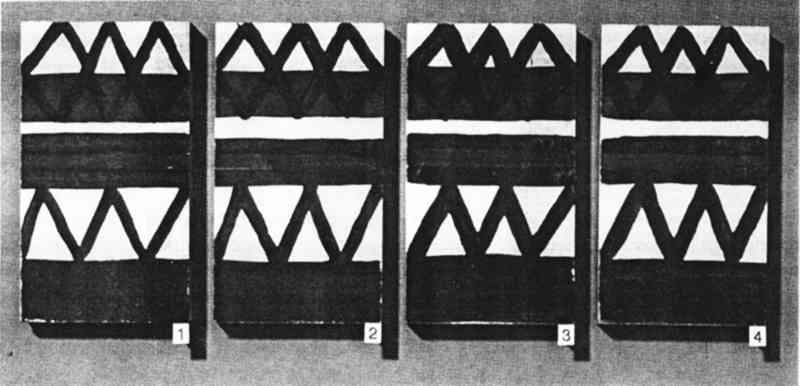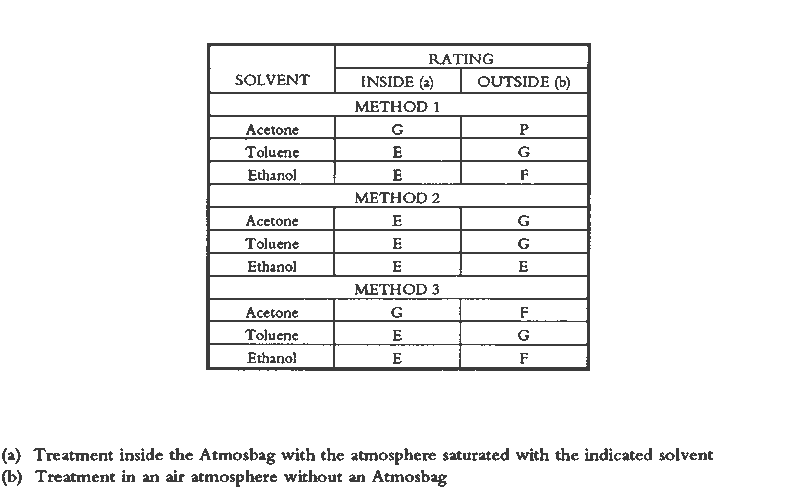CONSOLIDATION OF POROUS PAINT IN A VAPOR-SATURATED ATMOSPHEREERIC F. HANSEN, ROSA LOWINGER, & EILEEN SADOFF
6 RESULTS AND DISCUSSION6.1 CHOICE OF MATERIALS AND METHODSThe ochres and kaolin used in this study could be applied as colorants from an aqueous dispersion with no binder. This type of paint was chosen because such an easily smudged and powdering surface might be encountered in a museum object requiring consolidation. The simple, multicolored geometric pattern was selected for its similarity to many designs found on ethnographic objects. The three methods used to apply the consolidant are those frequently used by conservators. In particular, dabbing does not drag pigments of one color onto an area pigmented with another color, but it may result in tide lines. Different application procedures were employed, because the conservator's skill in applying a consolidant The Atmosbag is an inexpensive device for maintaining a high concentration of solvent in a convenient working space. It comes in a variety of sizes, has gloves attached, and is easily sealable. It has been previously suggested for use in humidifying objects and working on them in a controlled humidity maintained with saturated salt solutions (Maltby 1987). Any other system for creating an enclosed space that is impermeable to solvent vapors and allows both manipulation of objects and visibility—such as glove boxes or glove bags of other materials and designs—would also be suitable. It is important to note that the manufacturers do not recommend the Atmosbag for safe control of solvent vapors, and it should be used in a fume hood, as should any other system. 6.2 EVALUATION SYSTEM AND RATINGIf consolidation by introducing a resin can be avoided and a nonintrusive conservation method—such as proper storage conditions—can be used instead, such a method is usually preferable. This is often not an option, however, for an object with powdering paint; the surface must be consolidated, even if some discoloration results. But the changes resulting from the necessary consolidation can be minimized, though not necessarily prevented. A qualitative rating system was developed to enable conservators to judge whether their work is within acceptable limits. Consolidation strength was estimated by the difficulty of smudging the surface by pressure applied with a finger. Consolidation was acceptable in every case, an expected finding with solutions of a fairly high working concentration (5% w/v). Consolidation was poorer in a few instances when xylene and DEB had been used as solvents. Because consolidation was tested two weeks after treatment, these results may relate to retained solvent alone, since these solvents have low boiling points. Although the effects on appearance listed below are interesting in regard to the correlation of the degree of discoloration with the volatility of the solvent, the more interesting phenomenon is that consolidation in a saturated atmosphere appears to be largely independent of solvent volatility. This result is readily apparent in the color reproductions (figs. 9–10) of the painted blocks consolidated by application method 2, dabbing.
The system used to rate the appearance of the paint after consolidation was:
Visual changes two weeks after treatment between consolidated areas and central unconsolidated areas were evaluated without knowledge of the particular solution used. The results (Tables 2, 3) support the following observations. For every solution tested, painted surfaces consolidated inside the bag looked better than those treated outside the bag. The application method is not as important in the case of consolidation inside the bag as it is for outside the bag.
Generally, outside the bag, the higher the volatility of the solvent, the poorer the appearance of the consolidated areas. Overall, outside the bag, the objects treated with AYAF solutions looked better than those treated with Acryloid B72. The one exception was B72/DEB, rated excellent. The best overall appearance outside the bag resulted from using B72/DEB and AYAF/ethanol; the best overall appearance inside the bag resulted when AYAF/ethanol was used; and the worst overall appearance outside the bag resulted from the use of B72/acetone. |



